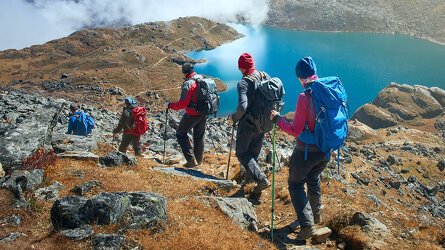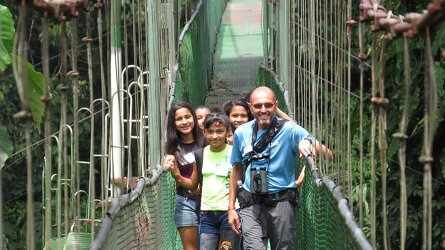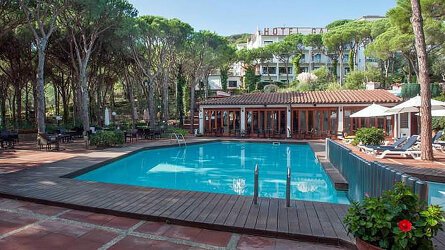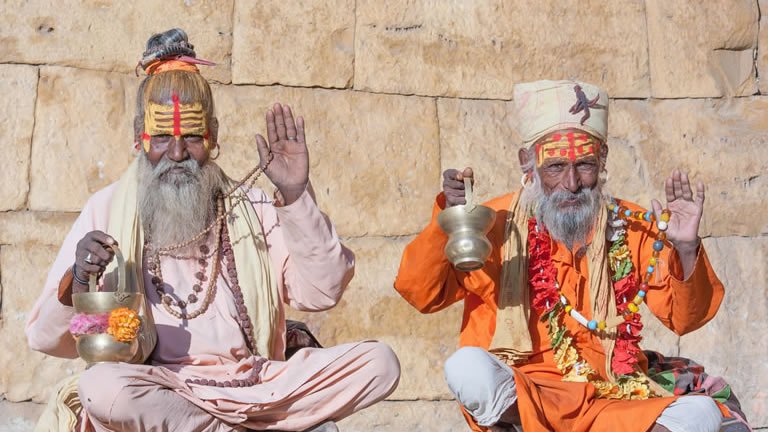Overview
Itinerary
Our adventure begins in Delhi, a city full of architectural masterpieces. Meet the group either at a named meeting point (normally the Hotel Bloom Karol Bagh) or Delhi Airport – see the Joining Instructions for more information. Once everyone has arrived, we depart for Jaipur, which may take between five and seven hours, depending on traffic conditions.
There's a lunch and toilet stop along the way and we have a welcome briefing at the hotel just before dinner. If you don't want to do this journey straight after your flight, we recommend spending a pre-tour night in Delhi – speak to your sales representative to book. Stay: 7 Apple Hotel – Jalmahal (or similar).
Rise early, heading out for a dawn walking tour as the Pink City begins to wake. Visiting different chowkris (blocks) within the walled city, we see the local people start their day and watch the rituals that take place in early morning markets and small temples. We can also interact with different artisan communities, while also sampling local food and drink. We return to the hotel in time for a later breakfast and to freshen up, before we head out again mid-morning. We visit one of the most intriguing sites in India, Jantar Mantar (Jaipur Observatory), an assembly of immense marble-and-brass astronomical instruments in a pleasant garden. We also see the impressive landmark, the Hawa Mahal (Palace of the Winds). Then travel just outside the main city to the Amber Palace, an imposing hilltop fort above a lake with large courtyards, finely decorated interiors and a Chamber of Mirrors. After, the tour leader generally takes the group to a textiles factory, which employs more than 400 local people. Tour the building to see every step of the production process, from block printing materials, pattern designing and assembly, to packaging and shipping. At the end, browse the shop and pick up anything from a complete outfit to handmade notebooks created with offcuts, so nothing is wasted. Stay: Hotel 7 Apple – Jalmahal (or similar) (B).
We wind through the villages of rural India to Ranthambore Tiger Reserve (approximately a five hour drive) ; staying in a hotel not far from the park entrance, we're well located for our two game drives in the park; one in the late afternoon and one the following morning. Ranthambore is one of the reserves set up by Project Tiger, a government-backed conservation programme launched in 1973. There was initial success, but poaching has drastically reduced the tiger population here and the chance of spotting one is small; however, many of our groups have seen tigers over the last few years.
Additionally, the latest census, the results of which were announced in late 2023, saw a 25 percent increase in tiger numbers: up to 88 from 69 in 2022. As we search for tigers, we also hope to see the other wildlife living here: several deer species, crocodiles, and bird life including purple herons, kingfishers, cormorants, parakeets and partridges. Stay: Raj Palace Resort (or similar) Please note, occasionally the game drive timings or zones may be adjusted depending on government restrictions and changes in national park zonal opening/closing times (B).
We have an early start this morning, heading out before breakfast for our second game drive. Returning to the hotel in time for breakfast and a chance to freshen up before check out. We next continue our journey on to Agra via Fatehpur Sikri, Emperor Akbar's deserted royal city. This impressive and well-preserved citadel became his capital in 1571, after the blessing of a local Moslem holy man correctly predicted the birth of a longed-for son: his successor, the emperor Jehangir.
The mosque, designed to hold 10,000 worshippers, the palaces, residences, and halls of audience, are all made of decorative red sandstone. But this magnificence only lasted 14 years. In 1584, Akbar left Fatehpur Sikri to secure his outlying territories, leaving this city much as we see it today – in perfect condition. We arrive in Agra early evening, this is another very full but rewarding day. The total driving time is approximately seven hours. Stay: Hotel Avalon Palms (or similar) (B/L).
Today we wake early to visit the Taj Mahal at sunrise, which was built by the Moghul Emperor Shah Jahan in memory of his beloved wife, Mumtaz Mahal, who died in 1631. The Taj is serenely beautiful and never fails to amaze a first-time visitor; the white marble exterior changes colour according to the position of the sun and is matched by the rich interior detail.
Within striking distance is the imposing Red Fort of Akbar, whose mighty sandstone walls enclose the beautiful white marble Pearl Mosque and the palaces, halls, courtyards and fountains of Emperor Akbar's sons and successors: Jehangir and Shah Jahan. It is here that the latter spent his last years, imprisoned by his own son Aurangzeb.
Later in the day, we transfer to Agra train station and join the overnight sleeper train to Varanasi. A light snack is provided on the overnight train journey. Stay: Sleeper train (B).
We arrive in Varanasi in the morning and transfer to our hotel. For information about hotel check-in times please see our “Worth Knowing” section within the Trip Notes. On the river Ganges, Varanasi is one of the holiest cities in India and stands at the centre of the Hindu universe. As such, the city lives and breathes Hinduism: there are thousands of pilgrims, wandering holy men (Sadhus), religious elders and casual visitors. It is a city to immerse yourself in: explore the maze of narrow lanes and many temples and watch the Hindu ceremonies that take place around the clock. There is time to visit emporiums specialising in silks and brocades or maybe take a massage by the riverbanks.
In the afternoon, we can take an optional visit to nearby Sarnath Temple. Sarnath is as sacred to Buddhists as Varanasi is to Hindus. The main monument at Sarnath is the Dhamekh Stupa, the very spot where Buddha is believed to have given his first sermon. There's also an archaeology museum, which exhibits Buddhist artefacts and houses the findings of excavations from the Sarnath site. Your tour leader can organise various optional sightseeing trips during your two days here. Stay: Hotel Surya (or similar) (B).
Just before dawn, we take a boat ride on the Ganges to witness the extraordinary spectacle on the ghats, the steps leading down to the river. Every day, thousands of Hindu pilgrims come to this 3mi (5km) stretch of riverbank to soak in the holy waters.
This afternoon, we board the Vande Bharat Express train back to Delhi, a great opportunity to see and experience more of India as you pass through rural villages, towns and cities. A light snack dinner is provided, which usually includes a soup and light meal with rice and vegetables. You may wish to pick up some additional snacks/fruit prior to boarding. We arrive in Delhi late evening and transfer to the hotel. Stay: Bloom Hotel Karol Bagh (or similar) (B/D).
Today you are free to relax or explore the sites of New and Old Delhi (an optional sightseeing trip will be organised if you wish). Recommended sites include the Red Fort, Humayun's Tomb, India Gate, Jama Masjid (the largest mosque in India), Sheeshganj Gurudwara (Sikh Temple) and Raj Ghat. For last-minute shopping, visit the market area of Chandni Chowk or Karol Bagh. Stay: Bloom Hotel Karol Bagh (or similar) (B).
Our adventure through northern India ends today. If you've still a few pages left in your travel diary, speak to your sales representative about extending your stay in Delhi. Alternatively, make your way to the airport and begin your return journey home (B).
Trip Inclusions
- Discover the highlights of northern India: rich culture, amazing wildlife and tasty cuisine
- Complete the famed Golden Triangle, visiting Delhi, Agra and Jaipur
- See the unforgettable Taj Mahal
- Maximize your chances of spotting a tiger in Ranthambore National Park with two game drives
- Marvel as thousands of pilgrims soak in the holy waters of the Ganges on a dawn boat ride in Varanasi
- 7 Classic nights (hotels), 1 Simple night (sleeper train)
- Travel by air-conditioned private bus and train
- Holi and Diwali festival departures available (see Dates & Prices tab)
- Meals as stated on the itinerary
- All transport
- Entrances fees to monuments in Jaipur and Agra (as per itinerary)
- Two jungle safari (as per itinerary)
- Tour leader throughout
- Free departure transfers for everyone
- Itinerary and inclusions are subject to change
- Price is for land, cruise and internal flights as specified. Flights not specified are not included

From classic small group tours & family adventures, to walking holidays, cycling trips and self-guided tours. Read more

Exodus chooses their Leaders carefully. Professional, dedicated and are passionate about sharing their home countries. Read more

Wherever possible, Exodus chooses properties that are locally owned and that reflect the area you are visiting. Read more
Availability
 USD
USD
A definite departure means minimum numbers have been reached for this departure to operate. Your Global Journeys Travel Advisor will check the availability of your departure date when you enquire. Additional savings may apply. We guarantee the lowest price in USA. T&C’s apply.
Tour & cruises prices are per person. Prices shown have savings applied, are subject to availability and may be withdrawn at any time without notice. Pricing and trip details are correct at this point in time, however are subject to confirmation at the time of booking and are subject to change by Exodus. For cruise itineraries, cabin images are sourced from Exodus. These should be treated as indicative only. Cabin inclusions, upholsteries and room layout may differ to the image(s) shown depending on the ship selected and your sailing dates.









